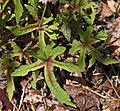Tiarella
| Tiarella subsp. var. | Foamflower | |||||||||||||||||||||||||||||||||||||||||||||||||||||||
|---|---|---|---|---|---|---|---|---|---|---|---|---|---|---|---|---|---|---|---|---|---|---|---|---|---|---|---|---|---|---|---|---|---|---|---|---|---|---|---|---|---|---|---|---|---|---|---|---|---|---|---|---|---|---|---|---|

|
|
| ||||||||||||||||||||||||||||||||||||||||||||||||||||||
| ||||||||||||||||||||||||||||||||||||||||||||||||||||||||
The Foamflowers (Tiarella) are a popular genus of wildflower and garden plants. They belong to the Saxifrage family (Saxifragaceae).
| Standard Cyclopedia of Horticulture |
|---|
|
Tiarella (Latin, a little tiara or turban; in reference to the form of the pistil). Saxifragaceae. False Mitrewort. Slender erect hardy perennial herbs, useful for the wild-garden or any shaded spot. Leaves several, radical, long-petioled, simple or 3-foliate: stipules small, adnate to the petiole: raceme terminal, somewhat bracteate, simple or compound: fls. white or reddish; calyx-tube short, lobes 5, ovate; petals 5, entire; stamens 10; ovary superior, compressed, 1-celled: caps. membranaceous, 1-celled, 2- valved. — About 8 species, 1 from Japan, 1 from the Himalayas, the remainder from N. Amer. These plants are little grown, but they are useful for colonizing or perhaps for the rock-garden and are particularly attractive in the autumn on account of their brilliant lf.-coloring. Prop. by division. T. biternata, Vent - Astilbe biternata. CH
|
Cultivation
- Do you have cultivation info on this plant? Edit this section!
Propagation
- Do you have propagation info on this plant? Edit this section!
Pests and diseases
- Do you have pest and disease info on this plant? Edit this section!
Species
- Tiarella cordifolia (Heartleaved Foamflower)
- Tiarella trifoliata (Threeleaved Foamflower)
- Tiarella polyphylla
- Tiarella wherryi
- Tiarella Hybrid Cultivars
- Tolmiea (piggyback plant)
Gallery
If you have a photo of this plant, please upload it! Plus, there may be other photos available for you to add.
-
photo 1
-
photo 2
-
Tiarella 'Cygnet' leaves
References
- Standard Cyclopedia of Horticulture, by L. H. Bailey, MacMillan Co., 1963
External links
- w:Tiarella. Some of the material on this page may be from Wikipedia, under the Creative Commons license.
- Tiarella QR Code (Size 50, 100, 200, 500)


